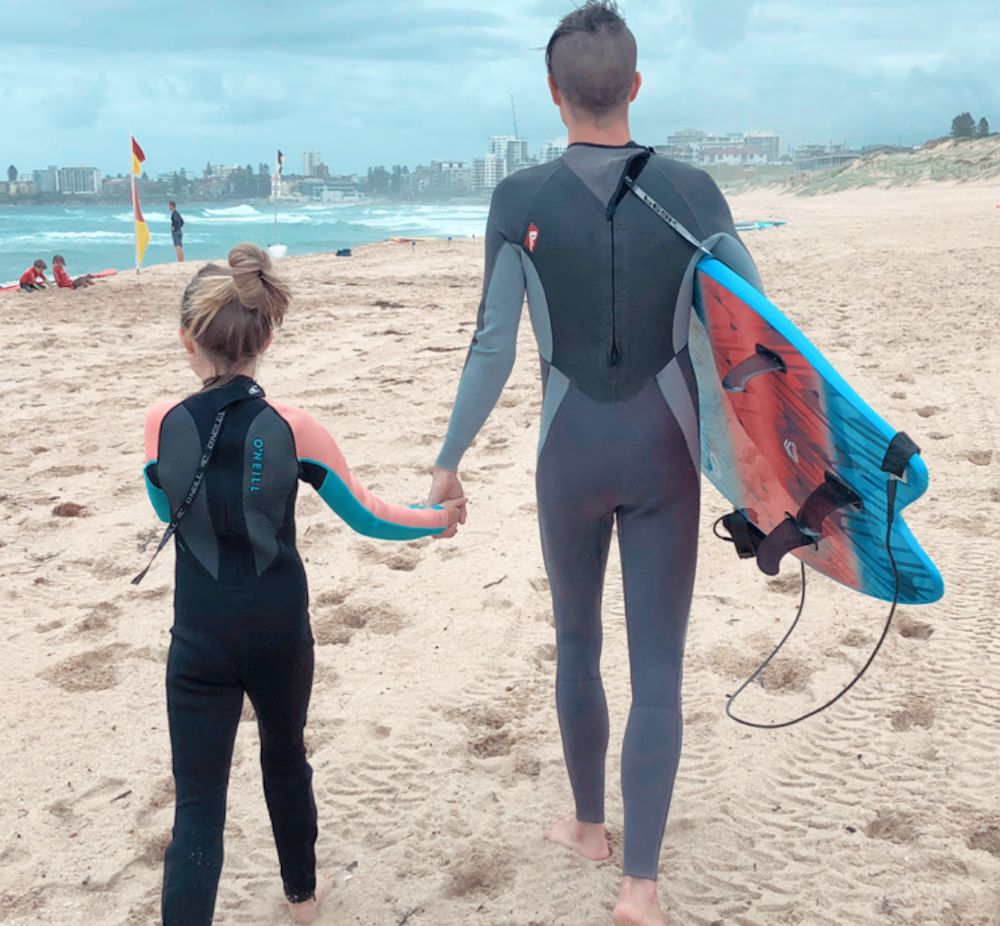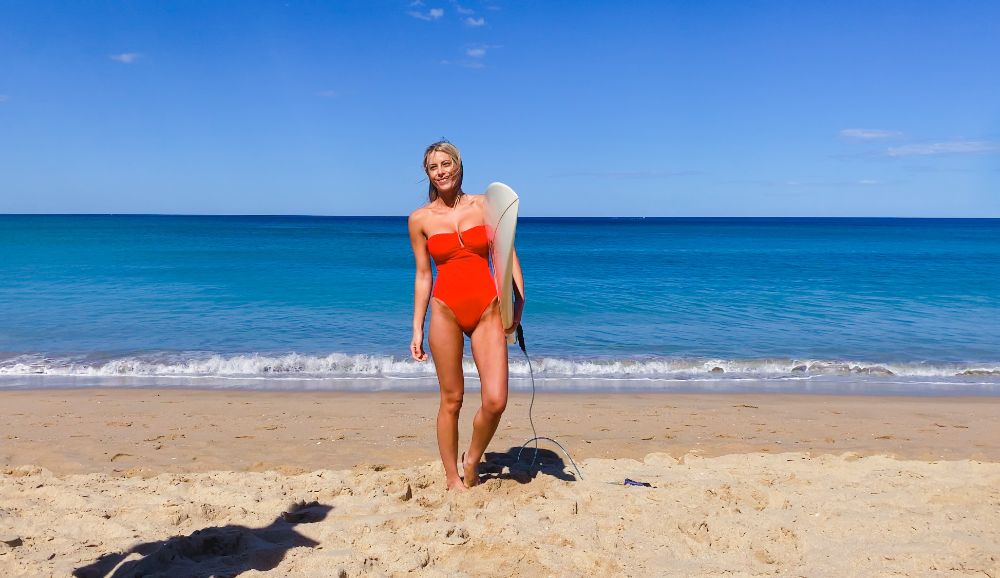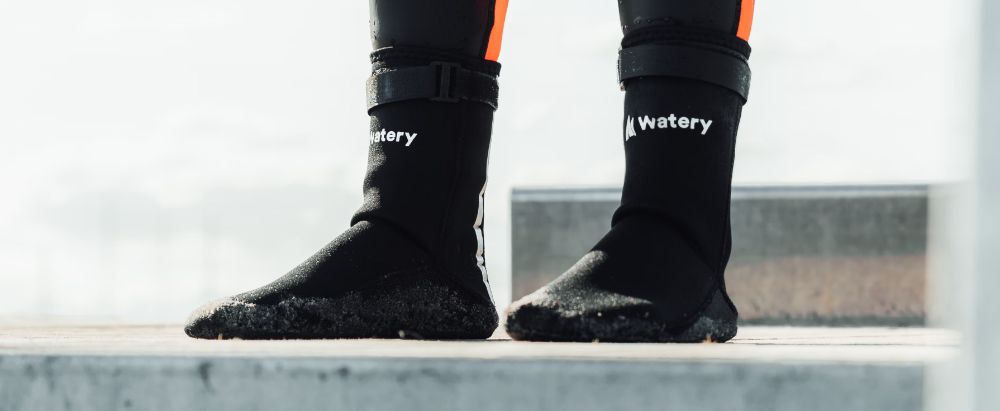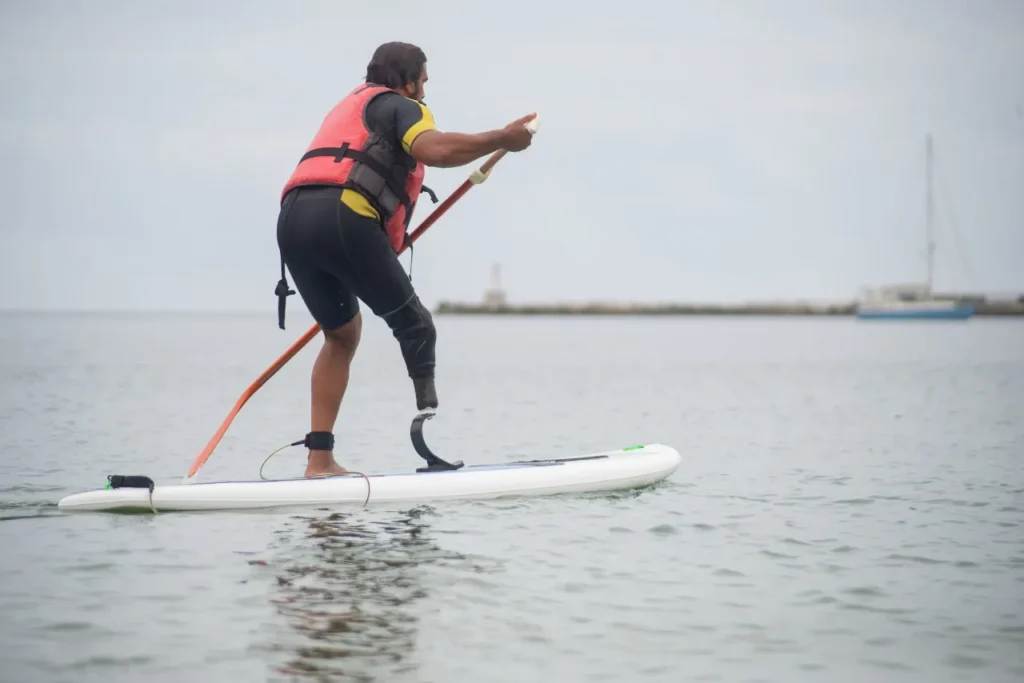Figuring out what to wear during the spring months of paddling can be difficult. Air temperatures are likely warmer but not strong enough to warm the water’s temperature yet, so how do you dress?
In the spring, you generally want to dress for cold water temperatures when paddle boarding, but not something too thick that will cause you to be uncomfortably hot in the sun.
A good choice would be a light wetsuit or a full bathing suit, board shorts and a rash vest. For more experienced paddle boarders who are unlikely to fall in then regular clothing for your local climate can be worn.
The biggest thing is that in spring the outside weather is generally warmer but the water is usually still just as cold (if not colder) than it was in winter. Falling into the water, plus wind chill factors can make you cold quite quickly if you aren't prepared for it.
This is why a light wetsuit is usually a good option. Not too hot for the outside weather but you won't get so cold if you fall into the water and get wet.
Don’t forget essential accessories like sunglasses, a sun hat, and sun protection. Standing out in the sun for long periods means lots of UV exposure and no shade to hide from it.
The Essential Clothing & Accessories For Paddle Boarding In The Spring

You’ve switched on the weather forecast. It’s sunny in the afternoon but showers in the morning. Typical spring, eh?
A big mistake that many paddle boarders make when checking the weather is assuming the air temperature equals the water temperature.
Outside temperature DOES NOT reflect water temperature and ocean temperatures usually lag 2-3 months behind outside temperatures – making the water even colder in spring than it is in water.
Depending on where you are paddle boarding the water temperatures will change drastically. Spring water temperatures close to the equator will obviously be a lot warmer then spring temperatures further away from the equator.
You must ensure you are dressed well enough to prevent thermal shock when falling into cold waters. Check your local water temperatures and the following table to give you a rough guide on whether or not you need a wetsuit and what thickness and type of wetsuit you might require:
| Water Temp. | Hot/Sunny Day | Cold/Windy Day |
|---|---|---|
| >72ºF/22ºC | Rash Guard | Insulated Rash Guard |
| 65-75ºF/18-24ºC | Insulated Rash Guard | 1-2mm Wetsuit |
| 62-68ºF/14-17ºC | 2-3/2mm Springsuit/Steamer | 2-3/2mm Steamer (maybe Boots/Gloves) |
| 52-58ºF/11-14ºC | 4/3-5/4/3mm Steamer | 4/3-5/4/3mm Steamer + Boots/Gloves/Hood |
| 43-52ºF/6-11ºC | 5/4-5/4/3 mm Steamer + Boots/Gloves/Hood | 6/5-7mm+ Steamer + Boots/Gloves/Hood |
| <42ºF/6ºC | 6/5-7mm+ Steamer + Boots/Gloves/Hood | 6/5-7mm+ Steamer + Boots/Gloves/Hood |
Below are some of the great options for both men and women of what you can wear paddle boarding in the spring time.
Thin Wetsuit

If it’s heating up outside but still a bit nippy, a thin wetsuit is likely the first resort.
You can choose short versions to keep your legs bare or versions that have no sleeves. There are also insulated rash guards which can provide some thermal insulation without making you too hot.
Wetsuits will keep your core temperature in check if you fall off your board and end up submerged in the water, but if the wetsuit is too thick then you can overheat, especially if you're not getting wet often.
Full Wetsuit

Depending on where you live it make still be extremely cold in spring with cold water temperatures and a strong wind chill factor.
Temperatures a the start of spring can also be vastly different to temperatures at the end of spring.
If it's still quite cold then you make want to opt for a full length wetsuit (also called a steamer) that is 2-3 inches thick or even thicker for extremely cold climates.
Full Swim Suit or Bikini

For women, a full swimsuit may be the best bet in the spring months or a bikini when it’s super warm outside.
If the sun is shining, wind chill factor is little to none and you don't think you'll be getting wet often then a simple swimsuit will be all you need.
Just make sure to wear sunscreen.
Rash Guard

Rash guards made from polyester or spandex protect you from the sun’s UV rays and can also cut down on the wind chill factor when you are dry.
They are extremely popular for all sorts of water sports and highly recommended to protect your skin.
The only downside of rash guards is that they can make you cold when they are wet as they can increase the wind chill.
Board Shorts

Loose-fitting board shorts will keep you cool on a warmer day and dry out quickly if they get wet.
This is generally what I'll wear paddle boarding, with a rash guard to protect me from the sun.
Water Shoes

You can paddle barefoot without any issues. Many prefer this in the spring/summer months.
But, there is an increased risk of injuries.
Water shoes can be an excellent choice for protection and will be breathable too.
Sunglasses

A pair of shades will protect your eyes from that glaring sun when paddle boarding.
Sun Hat
There’s no particular hat you need for paddle boarding, any kind to protect your head will do the job.
Neck flap ones are great if you want to avoid a sunburned neck.
Paddle Jacket

A paddle jacket may be required in spring if temperatures are still a little colder.
Opt for a lightweight jacket to keep you dry and warm, just in case.
Sun Cream
You need a decent sun cream when paddling out in the sun, up to SPF 50+ is recommended. Apply to all areas that will be exposed to the sun.
Apart from the above, remember your PFD (personal floating device) and leg leash.
What Thickness Should My Wetsuit Be When Paddle Boarding In The Spring?

When the temperatures start to warm up, but the winds are chilly, a thin wetsuit is my first choice, and you can always wear them half-done up if you want more breathability.
You want to make sure you understand the thickness to choose the right wetsuit. If it is too thick, you’re going to be uncomfortable with the heat. If it is too thin, you are at risk of thermal shock when entering the water.
Let’s say it’s 64-70ºF/18-20ºC outside and water temperatures above 68ºF/17ºC. Then, a 1-2mm wetsuit with short sleeves will be a good choice.
If temperatures are between 54-62ºF/12-17ºC, then a 3/2 mm with longer sleeves is the smarter option.
| Water Temp. | Hot/Sunny Day | Cold/Windy Day |
|---|---|---|
| >72ºF/22ºC | Rash Guard | Insulated Rash Guard |
| 65-75ºF/18-24ºC | Insulated Rash Guard | 1-2mm Wetsuit |
| 62-68ºF/14-17ºC | 2-3/2mm Springsuit/Steamer | 2-3/2mm Steamer (maybe Boots/Gloves) |
| 52-58ºF/11-14ºC | 4/3-5/4/3mm Steamer | 4/3-5/4/3mm Steamer + Boots/Gloves/Hood |
| 43-52ºF/6-11ºC | 5/4-5/4/3 mm Steamer + Boots/Gloves/Hood | 6/5-7mm+ Steamer + Boots/Gloves/Hood |
| <42ºF/6ºC | 6/5-7mm+ Steamer + Boots/Gloves/Hood | 6/5-7mm+ Steamer + Boots/Gloves/Hood |
Can You Wear Normal Clothes Paddle Boarding In Spring?

You could technically wear regular clothes when paddle boarding if you're confident you won't fall in the water.
This is very common for confident paddle boarders going onto calmer waters. But if you're new to paddle boarding you chances of falling in are much higher so regular clothes won't be ideal.
Regular clothes don’t offer any warmth protection when wet and will get heavy and restricting if wet.
Above all, avoid cotton clothing whenever you paddle boarding. Cotton holds water rather than drying out.




